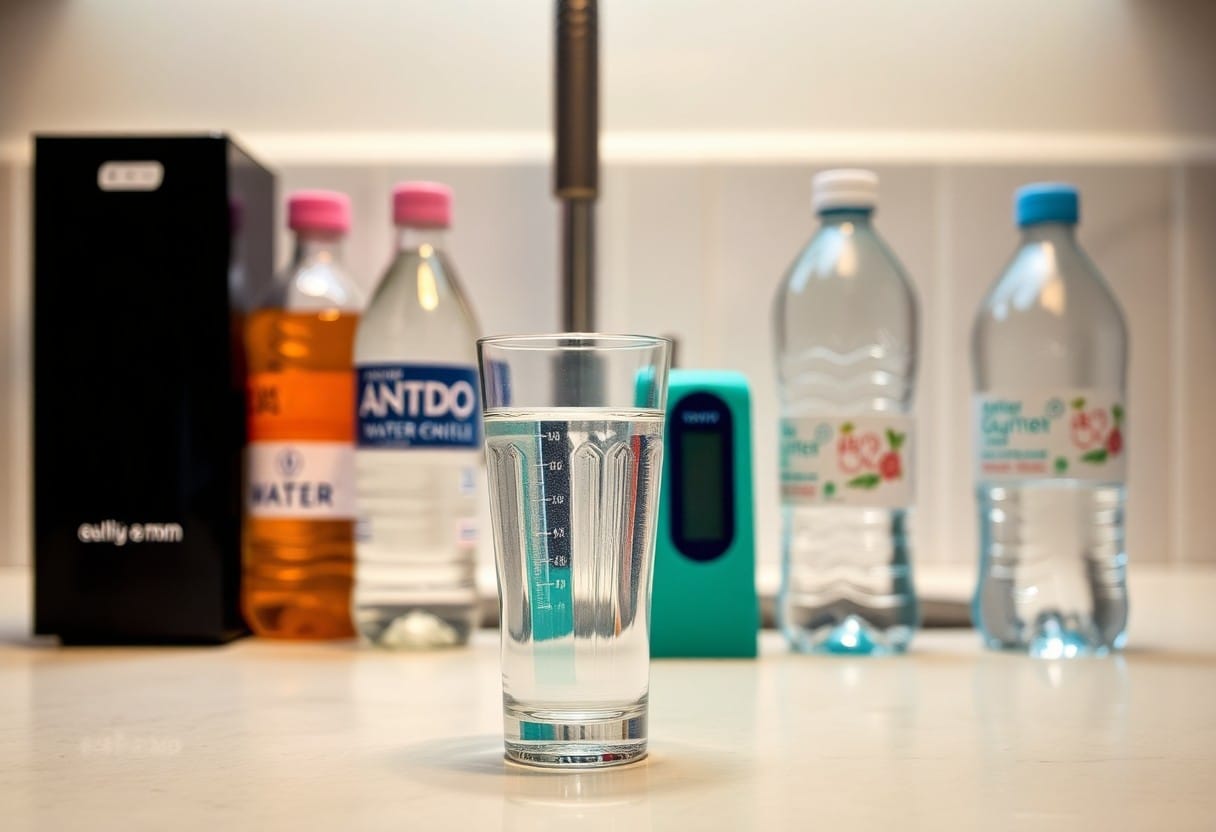There’s an increasing concern about PFAS, or per- and polyfluoroalkyl substances, lurking in your drinking water. These substances, often referred to as “forever chemicals,” can pose serious health risks, including cancer and hormone disruption. Knowing how to detect PFAS in your water supply is vital for ensuring your family’s safety. In this guide, you will learn effective methods to test for these harmful chemicals and understand the steps you can take to safeguard your health and well-being.
What are PFAS?
For many, understanding the term PFAS can be daunting. PFAS, or per- and polyfluoroalkyl substances, represent a group of synthetic chemicals known for their ability to repel water and grease, making them useful in various industries.
Definition and Types
With numerous compounds falling under the PFAS umbrella, you might want to familiarize yourself with their definitions:
| Definition | PFAS are man-made chemicals resistant to environmental degradation. |
| Types | Common types include PFOA, PFOS, and GenX. |
- PFAS – per- and polyfluoroalkyl substances
- PFOA – perfluorooctanoic acid
- PFOS – perfluorooctane sulfonate
- GenX – new replacements for PFOA
- Assume that understanding these terms helps you better navigate potential contaminants.
Sources of PFAS Contamination
Among the various sources you should be aware of, PFAS can seep into your drinking water primarily from industrial discharges, wastewater treatment plants, and even everyday household products.
PFAS are prevalent due to their extensive use in products like non-stick cookware, water-repellent clothing, and firefighting foam. Over time, these substances can leach into the environment, affecting your soil and water supply. Contamination often arises from industrial sites where PFAS were manufactured or used. Even runoff from landfills can contribute to elevated levels of PFAS in drinking water. Staying informed helps you take measures to ensure your water quality is safe.

Health Risks Associated with PFAS
Any exposure to PFAS chemicals in your drinking water may lead to a range of health issues. These substances, often referred to as “forever chemicals,” can accumulate in your body over time, posing various risks to your health. Studies suggest that PFAS exposure could be linked to an increased risk of certain cancers, liver damage, and thyroid disorders, highlighting the importance of ensuring the safety of your drinking water.
Short-term Effects
On a short-term basis, exposure to PFAS may result in symptoms such as skin irritations and allergic reactions. You could also experience changes in cholesterol levels or disruptions in your hormonal balance. While these effects might appear minor initially, they can still indicate underlying hormonal or immune system disruptions.
Long-term Effects
Short-term exposure may pose mild symptoms, but prolonged consumption can lead to far more serious health consequences. Long-term exposure to PFAS has been associated with a heightened risk of serious conditions like kidney and testicular cancer, as well as immune system dysfunction. Furthermore, studies have indicated links to developmental issues in fetuses and infants, including low birth weight and behavioral changes. Hence, being aware of the potential long-term health impacts of PFAS enables you to take proactive steps to protect not only your health but that of your family as well.
Regulatory Standards for PFAS
There’s a growing recognition of the need for regulatory standards regarding PFAS in drinking water, with various organizations implementing guidelines aimed at protecting public health. These standards focus on limiting exposure to PFAS compounds, which are linked to adverse health effects.
Current Guidelines
For your protection, the U.S. Environmental Protection Agency (EPA) recently updated its advisory levels for PFAS in drinking water, recommending a limit of 0.004 parts per trillion for PFOA and 0.02 parts per trillion for PFOS. These guidelines aim to reduce health risks associated with these persistent chemicals.
State-Level Regulations
StateLevel regulations vary significantly across the country, as individual states have the authority to enforce stricter standards for PFAS in drinking water. This means you may find differing limits on PFAS levels depending on where you live.
Even in states with established regulations, enforcement and compliance can differ, leaving you vulnerable to varying levels of PFAS contamination. Some states have set their own maximum contaminant levels (MCLs), which can be more stringent than federal guidelines. For example, places like California and New York have developed comprehensive frameworks for monitoring and regulating PFAS to ensure safe drinking water. As a resident, it’s vital to stay informed about your state’s specific regulations and take action if necessary to protect your water quality.
Methods for Detecting PFAS in Drinking Water
Not all methods for detecting PFAS are created equal. Understanding the various approaches can empower you to take action regarding your drinking water safety. Two primary methods exist: laboratory testing and at-home testing kits, each with its own advantages and disadvantages to consider.
Laboratory Testing
By opting for laboratory testing, you can achieve highly accurate results regarding PFAS levels in your drinking water. Certified laboratories use advanced analytical methods to detect low concentrations of these chemicals, often providing comprehensive reports that detail specific PFAS compounds present in your samples.
At-home Testing Kits
Methods such as at-home testing kits offer a convenient way for you to screen your water for PFAS contaminants. These kits usually come with simple instructions and can provide quick results, giving you immediate insight into the quality of your drinking water.
In fact, many at-home testing kits can detect multiple types of PFAS, allowing you to identify potentially harmful chemicals that may affect your health. While they might not always match the accuracy of laboratory results, they enable you to take swift action if your water shows elevated levels of contamination. Understanding your water quality in real-time allows you to make informed decisions about your drinking water safety and recognize the urgent need for remediation if needed.
How to Interpret Test Results
All water test results can seem overwhelming, but understanding them is vital for your health. Begin by looking for the presence of PFAS compounds and their concentrations. These results will help you determine potential risks associated with your drinking water and whether further action is necessary. Knowledge is your best ally in making informed decisions about your water safety.
Understanding PFAS Concentrations
Any levels of PFAS found in your drinking water should be taken seriously. Concentrations are usually measured in parts per trillion (ppt). A higher concentration suggests greater potential health risks. Therefore, it’s important to grasp what these numbers mean in the context of your water quality and to take action if any PFAS levels are concerning.
Comparing Results to Regulatory Standards
Between the test results and regulatory guidelines, you can evaluate how safe your water is. These guidelines often vary by state and organization, but they provide a benchmark to assess PFAS levels in your drinking water. Below is a table that helps you compare your results:
| Entity | Maximum Contaminant Level (MCL) in ppt |
|---|---|
| EPA | 70 |
| California | 10 |
| Michigan | 8 |
Considering the regulatory standards for PFAS, it is vital to assess your test results against these benchmarks. If your water’s PFAS concentrations exceed these limits, you may be at risk for health complications associated with PFAS exposure. Take note of any contaminants that surpass acceptable levels, and consult local health authorities for recommendations on how to safeguard your drinking water.
| Health Impact | Evidence Level |
|---|---|
| Cancer | Strongly associated |
| Hormonal disruption | Moderate evidence |
| Immune system effects | Emerging research |
Mitigation Strategies for PFAS Contamination
Many people are concerned about PFAS contamination in their drinking water, prompting the need for effective mitigation strategies. These approaches aim to reduce exposure to these harmful chemicals and protect your health. You can take proactive steps to improve your water quality through filtration systems and by participating in community efforts that raise awareness and promote clean water initiatives.
Filtration Systems
Before selecting a filtration system, consider options that are specifically designed to remove PFAS, such as activated carbon filters or reverse osmosis systems. These solutions can significantly reduce PFAS levels in your drinking water, providing a safer alternative for you and your family.
Community Efforts
The importance of community efforts in combating PFAS contamination cannot be overstated. Local initiatives can drive awareness and mobilize resources to address water quality issues collectively.
In fact, many communities have mobilized to advocate for legislation targeting PFAS pollution and monitoring programs to test water sources. By participating in such initiatives, you can contribute to a larger movement focused on ensuring clean, safe drinking water for everyone. Engaging with local organizations and attending public meetings on environmental issues can empower you and help shape your community’s response to these persistent contaminants.
To wrap up
From above, you’ve learned the importance of detecting PFAS in your drinking water to ensure your health and safety. By staying informed about potential sources of contamination and employing testing methods, you can take proactive steps in assessing the quality of your water. You should consider using certified laboratories for accurate testing and stay updated on local regulations regarding PFAS. Ultimately, understanding and addressing this issue empowers you to make informed decisions about your water consumption and wellbeing.





















